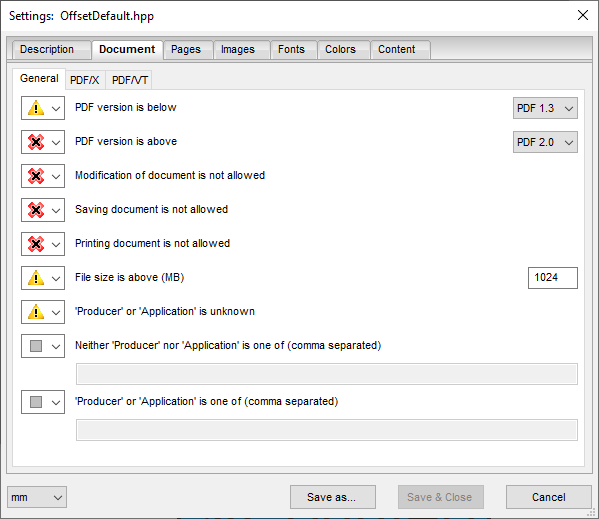

These are validation rules applying to the page-independent properties of the entire PDF file. Corresponding error messages do not refer to pages or page objects.
The following tabs are found:
PDF version is below / PDF version is above
You can choose from PDF 1.2 up to PDF 2.0.
Modification of document is not allowed / Saving document is not allowed / Printing document is not allowed
The default is "Error" in each case.
File size is above (MB)
This shows information if a set file size is exceeded.
"Creator" or "Application" is unknown
Example: "Creator" = "Acrobat Distiller" and "Application" = "QuarkXPress". Missing entries are mainly from outdated applications or exotic PDF creators.
Neither "Creator" nor "Application" is one of (comma separated)
This checks whether the user entered the name. For example: "Acrobat Distiller" means all Distiller versions, "Acrobat Distiller x.x" means only version x.x.
"Creator" or "Application" is one of (comma separated)
This checks whether the name is included. This means that "Acrobat Distiller" refers to all Acrobat Distiller versions. "Acrobat Distiller X" means only version X.
The "PDF/X" tab comprises details required for compliance with the PDF/X standard:
PDF does not comply with the requirements of
Checks the document for compliance with the selected PDF/X standard. Even if this check is not enabled here, the appropriate entry is set automatically in the PDF if all PDF/X requirements are met.
Trapped status is unknown
PDF/X requires a "Yes" or "No" for the trap status.
Document title is missing
PDF/X requires a PDF-internal document title.
Creation or modification date is missing
PDF/X requires a creation and modification date.
Filter is not PDF/X-compliant
Filters such as LZW or JPEG 2000 are not allowed in PDF/X.
Filter is not PDF/X-compliant
PDF/X Output Intent is missing
Checks whether the intent for which the PDF was prepared is set in the document.
PDF/X Output Intent is not (comma-separated)
If there is an intent, this checks whether its description contains one of the names.
In order to process PDF/VT files, the following requirements must be met:
•The number of pages per data record is the same for all data records
•The page sizes are identical for all data records
•The colors of each page are identical for all data records
The following test criteria are used to ensure that these requirements are met.
PDF/VT administration data do not match document
In the case of PDF/VT data, an overall page total results from a number of documents, each with a page total. Generally, the overall page total should match that in the PDF.
PDF/VT data sets have different page sizes
Different page sizes cannot be processed in the PDF/VT workflow.
PDF/VT data records use different colors
For the PDF/VT workflow, the colors must be identical for all documents
PDF/VT records have different numbers of pages
For PDF/VT workflow, the number of pages per record must be the same for all data records.
Arrangement of the pages in PDF/VT documents is not in ascending order
To output PDF/VT data correctly in digital printing, pages must be sequential across all data records in the document.
Number of data records in PDF/VT is greater than
Issues with the processing speed can occur if a PDF/VT has a great number of data records. A warning is issued if the number of data records exceeds the set value.
Percentage of reused objects in PDF/VT is less than (%)
For efficient printing, a PDF/VT document should have as high a proportion of reused, i.e. dynamic objects as possible.
If static content is repeated several times in a PDF/VT document, this has an unnecessary negative effect on the printing speed.
This option checks whether the percentage of dynamic objects in the total number of objects is less than the value entered. If this is the case, the document can be reviewed and optimized if necessary.